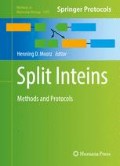Abstract
Proteins purified using affinity-based chromatography often exploit a recombinant affinity tag. Existing methods for the removal of the extraneous tag, needed for many applications, suffer from poor efficiency and/or high cost. Here we describe a simple, efficient, and potentially low-cost approach—split intein-mediated ultrarapid purification (SIRP)—for both the purification of the desired tagged protein from Escherichia coli lysate and removal of the tag in less than 1 h. The N- and C-fragment of a self-cleaving variant of a naturally split DnaE intein from Nostoc punctiforme are genetically fused to the N-terminus of an affinity tag and a protein of interest (POI), respectively. The N-intein/affinity tag is used to functionalize an affinity resin. The high affinity between the N- and C-fragment of DnaE intein enables the POI to be purified from the lysate via affinity to the resin, and the intein-mediated C-terminal cleavage reaction causes tagless POI to be released into the flow-through. The intein cleavage reaction is strongly inhibited by divalent ions (e.g., Zn2+) under non-reducing conditions and is significantly enhanced by reducing conditions. The POI is cleaved efficiently regardless of the identity of the N-terminal amino acid except in the cases of threonine and proline, and the N-intein-functionalized affinity resin can be regenerated for multiple cycles of use.
Access this chapter
Tax calculation will be finalised at checkout
Purchases are for personal use only
References
Waugh DS (2005) Making the most of affinity tags. Trends Biotechnol 23(6):316–320. doi:10.1016/j.tibtech.2005.03.012
Isetti G, Maurer MC (2007) Employing mutants to study thrombin residues responsible for factor XIII activation peptide recognition: a kinetic study. Biochemistry 46(9):2444–2452. doi:10.1021/bi0622120
Kapust RB, Tozser J, Fox JD, Anderson DE, Cherry S, Copeland TD, Waugh DS (2001) Tobacco etch virus protease: mechanism of autolysis and rational design of stable mutants with wild-type catalytic proficiency. Protein Eng 14(12):993–1000
Gasparian ME, Ostapchenko VG, Schulga AA, Dolgikh DA, Kirpichnikov MP (2003) Expression, purification, and characterization of human enteropeptidase catalytic subunit in Escherichia coli. Protein Expr Purif 31(1):133–139
Waugh DS (2011) An overview of enzymatic reagents for the removal of affinity tags. Protein Expr Purif 80:283–293
Saleh L, Perler FB (2006) Protein splicing in cis and in trans. Chem Rec 6(4):183–193. doi:10.1002/tcr.20082
Evans TC, Xu MQ (1999) Intein-mediated protein ligation: harnessing natures’ escape artists. Biopolymers 51(5):333–342
Shi J, Muir TW (2005) Development of a tandem protein trans-splicing system based on native and engineered split inteins. J Am Chem Soc 127(17):6198–6206
Lew BM, Mills KV, Paulus H (1999) Characteristics of protein splicing in trans mediated by a semisynthetic split intein. Biopolymers 51(5):355–362. doi:10.1002/(SICI)1097-0282(1999)51:5<355::AID-BIP5>3.0.CO;2-M
Southworth MW, Amaya K, Evans TC, Xu MQ, Perler FB (1999) Purification of proteins fused to either the amino or carboxy terminus of the Mycobacterium xenopi gyrase A intein. Biotechniques 27(1):110–114, 116, 118–120
Mathys S, Evans TC, Chute IC, Wu H, Chong S, Benner J, Liu XQ, Xu MQ (1999) Characterization of a self-splicing mini-intein and its conversion into autocatalytic N- and C-terminal cleavage elements: facile production of protein building blocks for protein ligation. Gene 231(1–2):1–13
Li Y (2011) Self-cleaving fusion tags for recombinant protein production. Biotechnol Lett33(5):869–881.doi:10.1007/s10529-011-0533-8
Cui C, Zhao W, Chen J, Wang J, Li Q (2006) Elimination of in vivo cleavage between target protein and intein in the intein-mediated protein purification systems. Protein Expr Purif 50(1):74–81. doi:10.1016/j.pep.2006.05.019
Ramirez M, Valdes N, Guan D, Chen Z (2013) Engineering split intein DnaE from Nostoc punctiforme for rapid protein purification. Protein Eng Des Sel 26(3):215–223. doi:10.1093/protein/gzs097
Oeemig JS, Aranko AS, Djupsjobacka J, Heinamaki K, Iwai H (2009) Solution structure of DnaE intein from Nostoc punctiforme: structural basis for the design of a new split intein suitable for site-specific chemical modification. FEBS Lett 583(9):1451–1456. doi:10.1016/j.febslet.2009.03.058, S0014-5793(09)00248-8 [pii]
Guan D, Ramirez M, Chen Z (2013) Split intein mediated ultra-rapid purification of tagless protein (SIRP). Biotechnol Bioeng 110(9):2471–2481. doi:10.1002/bit.24913
Nichols NM, Benner JS, Martin DD, Evans TC Jr (2003) Zinc ion effects on individual Ssp DnaE intein splicing steps: regulating pathway progression. Biochemistry 42(18):5301–5311. doi:10.1021/bi020679e
Sun P, Ye S, Ferrandon S, Evans TC, Xu MQ, Rao Z (2005) Crystal structures of an intein from the split dnaE gene of Synechocystis sp. PCC6803 reveal the catalytic model without the penultimate histidine and the mechanism of zinc ion inhibition of protein splicing. J Mol Biol 353(5):1093–1105. doi:10.1016/j.jmb.2005.09.039
Johannes TW, Woodyer RD, Zhao H (2005) Directed evolution of a thermostable phosphite dehydrogenase for NAD(P)H regeneration. Appl Environ Microbiol 71(10):5728–5734. doi:10.1128/AEM.71.10.5728-5734.2005
Xu MQ, Perler FB (1996) The mechanism of protein splicing and its modulation by mutation. EMBO J 15(19):5146–5153
Nichols NM, Evans TC Jr (2004) Mutational analysis of protein splicing, cleavage, and self-association reactions mediated by the naturally split Ssp DnaE intein. Biochemistry 43(31):10265–10276. doi:10.1021/bi0494065
Zettler J, Schutz V, Mootz HD (2009) The naturally split Npu DnaE intein exhibits an extraordinarily high rate in the protein trans-splicing reaction. FEBS Lett 583(5):909–914. doi:10.1016/j.febslet.2009.02.003
Acknowledgements
Funding for this work was provided by the Norman Hackerman Advanced Research Program, National Science Foundation and the Chemical Engineering Department at the Texas A&M University.
Author information
Authors and Affiliations
Corresponding author
Editor information
Editors and Affiliations
Rights and permissions
Copyright information
© 2017 Springer Science+Business Media New York
About this protocol
Cite this protocol
Guan, D., Chen, Z. (2017). Affinity Purification of Proteins in Tag-Free Form: Split Intein-Mediated Ultrarapid Purification (SIRP). In: Mootz, H. (eds) Split Inteins. Methods in Molecular Biology, vol 1495. Humana Press, New York, NY. https://doi.org/10.1007/978-1-4939-6451-2_1
Download citation
DOI: https://doi.org/10.1007/978-1-4939-6451-2_1
Published:
Publisher Name: Humana Press, New York, NY
Print ISBN: 978-1-4939-6449-9
Online ISBN: 978-1-4939-6451-2
eBook Packages: Springer Protocols

